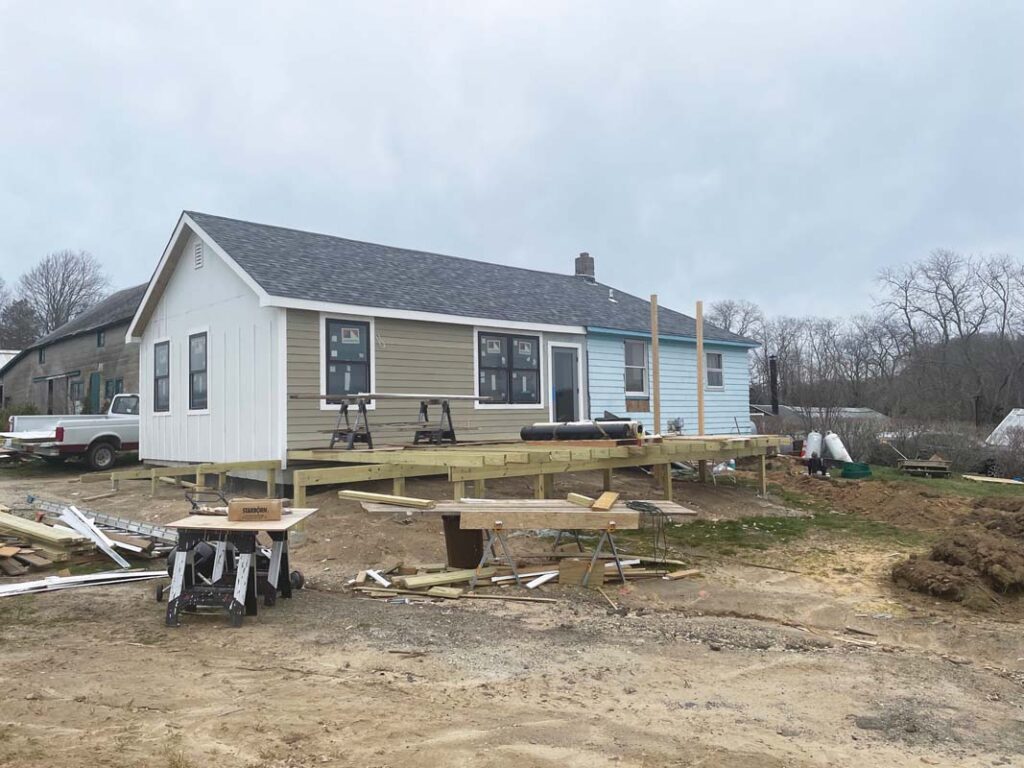Cutchogue’s Old House losing distinction as oldest English-style home in NYS

The Old House in Cutchogue has been promoted for more than a decade as the oldest English-style house in New York State, but scientific research may soon shave nearly 50 years off its age, local historians said.
The building, said to have been constructed in 1649, might actually have been built in 1698, according to Zach Studenroth, director of the Cutchogue-New Suffolk Historical Council. He said the new date first came to light in 2006 during research conducted by the Oxford Dendrochronology Laboratory in Oxford, England, and that information is currently being verified.
“It lost that claim to fame [as the oldest English-style house], but the best thing to say is it’s one of the finest surviving English-style homes around,” Mr. Studenroth said in an interview this week.
The Old House’s claim will likely now will revert to the Halsey House in Southampton, which was once believed to be built in 1648, but was redated to 1666 during a 2003 renovation project. Research associated with that particular renovation uncovered a deed showing that the Halsey House was actually a second-generation Halsey homestead in Southampton, according to the New York Times.
“All I can say is hahaha,” said Tom Edmonds, executive director of the Southampton Historical Museum, which maintains the Halsey House, upon learning of recent events. “It has been a rivalry, but a nice one — an academic discussion.
“We’ve known all along that we were the oldest house, ” he added.
Mr. Studenroth said the study to verify the date of the Old House is part of an ongoing reinterpretation of the building. The verification will be made through dendrochronology, or tree dating, in which researchers take a sample of the wood used to build the house.
Bill Flint, the dendrochronologist working on the current study, said the Oxford research was conducted as part of a larger examination of old homes across Long Island. In the previous study, three tree samples dated to 1698, he said.
“Zach had called me a while ago to kind of take additional samples to further solidify that data,” Mr. Flint said. “I’ve done the samples, got them measured, the data is in the computer. I haven’t had the time to fully analyze them yet.”

Southold Town historian Amy Folk said that without a dendrochronologist going around to other 17th-century homes across New York it’s difficult to tell exactly where any of the old-style homes rank, adding that there’s no official designation from the state. Ms. Folk said it’s more likely The Old House is among the three oldest houses in the state.
The Cutchogue property is in the midst of a three-year reinterpretation and refurnishing project led by the Cutchogue-New Suffolk Historical Council. The artifacts visitors might have seen on past tours of the property — including baskets, iron pots and a musket hanging over the fireplace — are not as accurate an interpretation as was once believed.
“The presentation has not been revised since 1940 and it is not very accurate to the time,” Mr. Studenroth said. “That was the inspiration for the project because it is [architecturally] the best example of the house during this time period.”
The restoration project will be funded through two charitable organizations, the Gerry Charitable Trust and Century Arts Foundation, for a grand total of $110,000 over the next three years.
The Old House was first discovered by the public in 1939 after a hurricane blew away trees, leaving it visible from the street. Objects in the house were donated by community members, but no one individual selectively chose those items.
Guest curator John Fiske will be in charge of overseeing the artifacts on display in the newly interpreted house. He has much experience handling items from the 17th century and is also the author of “When Oak was New: Furniture & Daily Life, 1530-1700.”
“John Fiske is a subject specialist,” Mr. Studenroth said. “We need someone who is an expert on the topic. He is working with us on a number of levels, like taking things out that were not appropriate.”
Mr. Fiske said he is mostly focused on the interior furnishings of the house, because while it is very well preserved structurally, the inside is much more haphazard.
“There was not a lot of coherence about the furniture,” he said “People don’t realize how sparsely furnished houses were in the late 17th century.”
Mr. Fiske expressed excitement over the project because it’s one of the most important houses in the English tradition.
“I think it will be very valuable for visitors and residents to see how people lived,” he said. “We will be able to tell a number of stories about the things that people did.”
Mr. Studenroth also explained that the house will not be specific to a certain year, but to the time period. Other planned improvements include improved handicapped accessibility and installation of interior lighting, because the very few windows make it difficult to see inside the house.
“It is always good to reinterpret things like the Old House as history advances,” Ms. Folk said. “There are waves where history becomes really popular and sometimes inaccurate voices creep into it.”
A behind-the-scenes tour will take place Sunday, Sept. 3, with Mr. Fiske, Mr. Studenroth and Cutchogue historian James Grathwohl leading the way. Mr. Fiske will also give a lecture Nov. 12 on his findings about the Old House.
Top photo: The Old House in Cutchogue, said to have been constructed in 1649, might actually have been built in 1698. (Credit: Krysten Massa)









